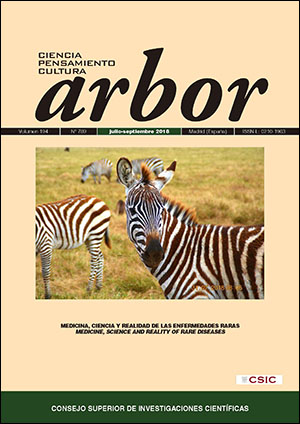Rare diseases of sigth
DOI:
https://doi.org/10.3989/arbor.2018.789n3004Keywords:
Inherited retinal dystrophies, optic nerve, corneal dystrophies, disorders of eye developmentAbstract
A large number of rare pathologies affect the eye or sight. A possible classification of these is according to the tissue that is affected. We can, therefore, define three main types of rare ocular disorders: 1) neuro-ocular pathologies, which basically affects the retina and optic nerve, 2) corneal dystrophies and 3) pathologies caused by deficiencies in the development of the eyeball or any of its parts. In all of them there is a clear Mendelian genetic basis and, currently, there is almost no treatment for any of them. The aim of this article is to provide a review of this set of pathologies.
Downloads
References
Ayuso, C. y Millán, J. M. (2010). Retinitis pigmentosa and allied conditions today: a paradigm of translational research. Genome Medicine, 2 (5), 34. https://doi.org/10.1186/gm155 PMid:20519033 PMCid:PMC2887078
Cepko, C. L. (2005). Effect of gene expression on cone survival in retinitis pigmentosa. Retina, 25 (8), pp. S21-S24. https://doi.org/10.1097/00006982-200512001-00008
Fuhrmann, S. (2010). Eye morphogenesis and patterning of the optic vesicle. Current Topics in Developmental Biology, 93, pp. 61-84. https://doi.org/10.1016/B978-0-12-385044-7.00003-5 PMid:20959163 PMCid:PMC2958684
Hamel, C. P. (2007). Cone rod dystrophies. Orphanet Journal of Rare Diseases, 2 (1), 7. https://doi.org/10.1186/1750-1172-2-7 PMid:17270046 PMCid:PMC1808442
Khanna, H. y Baehr, W. (2012). Retina ciliopathies: from genes to mechanisms and treatment. Vision Research, 75, p. 1. https://doi.org/10.1016/j.visres.2012.11.007 PMid:23206575
Klintworth, G. K. (2009). Corneal dystrophies. Orphanet Journal of Rare Diseases, 4 (1), 7. https://doi.org/10.1186/1750-1172-4-7 PMid:19236704 PMCid:PMC2695576
Lodha, N., Loucks, C. M., Beaulieu, C., Parboosingh, J. S. y Bech-Hansen, N. T. (2012). Congenital stationary night blindness: mutation update and clinical variability. En LaVail, M., Ash, J., Anderson R., Hollyfield, J. y Grimm, C. (eds.). Retinal Degenerative Diseases. Advances in Experimental Medicine and Biology, pp. 371-379. https://doi.org/10.1007/978-1-4614-0631-0_48
Ramamurthy, V. y Cayouette, M. (2009). Development and disease of the photoreceptor cilium. Clinical Genetics, 76 (2), pp. 137-145. https://doi.org/10.1111/j.1399-0004.2009.01240.x
Roosing, S., Thiadens, A. A., Hoyng, C. B., Klaver, C. C., Hollander, A. I. den y Cremers, F. P. (2014). Causes and consequences of inherited cone disorders. Progress in Retinal and Eye Research, 42, pp. 1-26. https://doi.org/10.1016/j.preteyeres.2014.05.001 PMid:24857951
You, Y., Gupta, V. K., Li, J. C., Klistorner, A. y Graham, S. L. (2013). Optic neuropathies: characteristic features and mechanisms of retinal ganglion cell loss. Reviews in the Neurosciences, 24 (3), pp. 301-321. https://doi.org/10.1515/revneuro-2013-0003
Published
How to Cite
Issue
Section
License
Copyright (c) 2018 Consejo Superior de Investigaciones Científicas (CSIC)

This work is licensed under a Creative Commons Attribution 4.0 International License.
© CSIC. Manuscripts published in both the printed and online versions of this Journal are the property of Consejo Superior de Investigaciones Científicas, and quoting this source is a requirement for any partial or full reproduction.All contents of this electronic edition, except where otherwise noted, are distributed under a “Creative Commons Attribution 4.0 International” (CC BY 4.0) License. You may read here the basic information and the legal text of the license. The indication of the CC BY 4.0 License must be expressly stated in this way when necessary.
Self-archiving in repositories, personal webpages or similar, of any version other than the published by the Editor, is not allowed.














